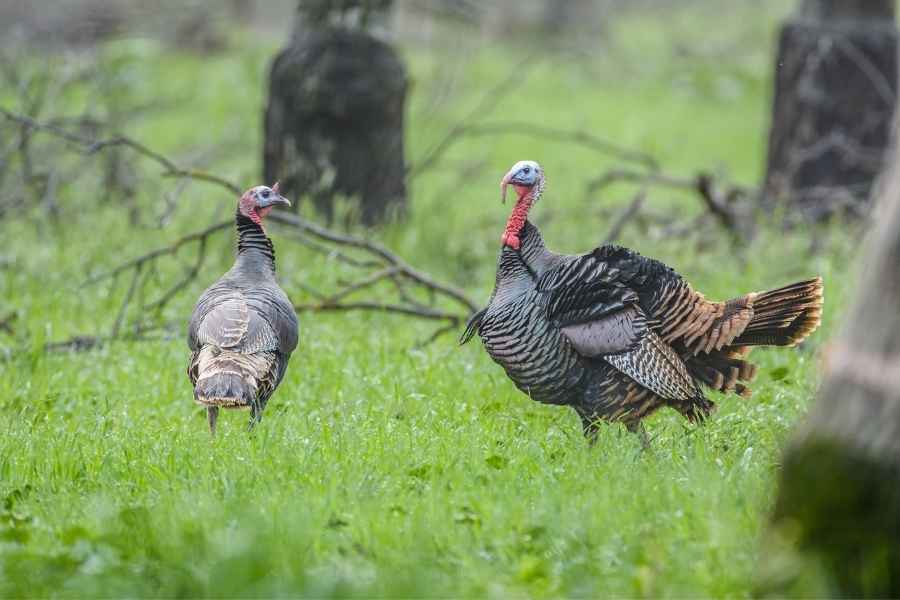Creating a compelling food plot for turkeys is like crafting the perfect meal. The right mix can significantly enhance turkey activity on your land.
This guide focuses on top choices for experienced bowhunters: clover and milo for attracting turkeys and insects and winter wheat and alfalfa for consistent nourishment.
We’ll also explore why your plot might have better options than Chufa.
Contents (Jump to Topic)
ToggleLet’s dive into developing superior food plots for turkeys.
Understanding Turkey’s Dietary Needs
For optimal turkey food plots, understanding their dietary preferences is critical. Turkeys are drawn to fresh shoots and insects, making clover and milo excellent choices.
Clover provides both foraging opportunities and attracts insects for poult growth.
Milo, sprouting early in spring, offers a dependable food source and can double as cover in your plot.
Including various plantings like legumes, wildflowers, and grains meets diverse turkey dietary needs.
Common Options that are Known to Attract Turkeys
- Clover: Clover plots are a popular choice for attracting turkeys. Ladino and white clovers are often used because they provide food and cover.
- Grain Sorghum: Grain sorghum can be an excellent option, as turkeys are attracted to the seeds it produces.
- Winter Wheat: Winter wheat is another good choice, providing a consistent food source through the fall and winter months.
- Crimson Clover: Crimson clover is a favorite among many hunters as it produces bright red flowers that attract turkeys. It’s often planted as a cover crop in larger plots.
- Native Grasses: Native grasses like switchgrass and little bluestem can provide cover and attract insects that turkeys feed on.
- No-Till Mixes: Many companies sell no-till seed mixes designed to attract turkeys. These blends typically include a variety of grains, legumes, and clovers.
- Wildflowers: Planting a mix of wildflowers can create a diverse and attractive food plot for turkeys and other wildlife.
Benefits of Clover Plots
Clover stands out in food plot planning due to its year-round appeal to turkeys. Different varieties, like white and crimson clover, offer a buffet hard for turkeys to ignore.
Flexible sowing times (spring or fall) make clover a practical choice. These plots attract not only turkeys but also bugs, crucial for young turkeys, and they appeal to deer as well.
The consistent blooming of clover ensures a steady food source, a key reason it’s a top choice for turkey plots.
Growing and Utilizing Milo
Milo, or grain sorghum, is an excellent choice for turkey plots. It’s easy to grow and a favorite among turkeys.
It greens early in spring, drawing turkeys sooner. After brush hogging, it becomes a hit with chicks.
Planting milo in strips covers open areas and sustains turkeys into early winter.
Milo’s ease of growth and effectiveness make it valuable in your food plot strategy.
Year-Round Food: Wheat and Alfalfa
Winter wheat and alfalfa are excellent for year-round sustenance. Winter wheat’s sprouts are particularly appealing to turkeys and offer necessary cover.
Alfalfa, though high-maintenance, draws in turkeys and deer in fall and spring due to its high protein and insect attraction.
While challenging, it’s an effective choice for keeping turkeys frequenting your plot.
Disadvantages of Chufa Plots
Chufa, popular in the south, presents challenges like high cost and specific soil requirements. It often attracts hogs and coons more than turkeys.
Chufa requires deep, sandy loam soil and may be less effective for wild turkey attraction, especially for mature birds.
The high cost and specific needs might make Chufa less practical for turkey food plots.
Before you go..
As an experienced bowhunter, you can now attract turkeys to your land. Clover and Milo are top picks for nutrition and cover.
Consider winter wheat and alfalfa for year-round food sources. Be mindful of the challenges with Chufa.
Happy planting, and here’s to successful turkey hunting!
Sources:
https://realtree.com/turkey-blog-with-steve-hickoff/5-food-plots-to-help-you-tag-more-turkeys
https://nabowhunter.com/the-best-food-plots-for-turkeys/
https://www.naturesseed.com/blog/attract-those-gobblers-with-turkey-food-plots/
https://www.archerytalk.com/threads/food-plots-for-turkey.4457081/
https://www.arkansashunting.net/threads/best-food-plot-for-turkeys.85757/






